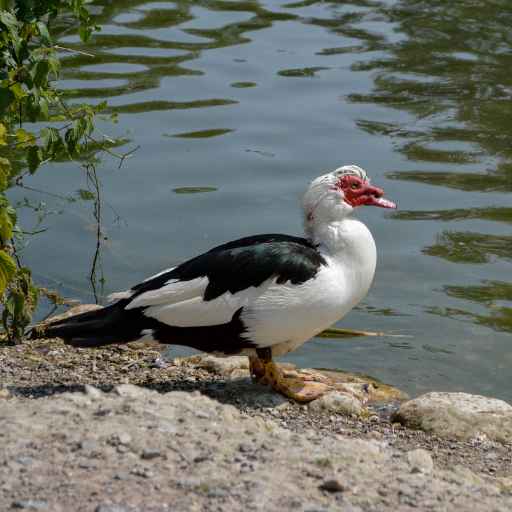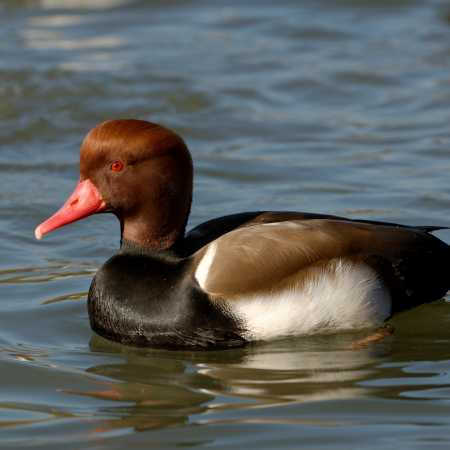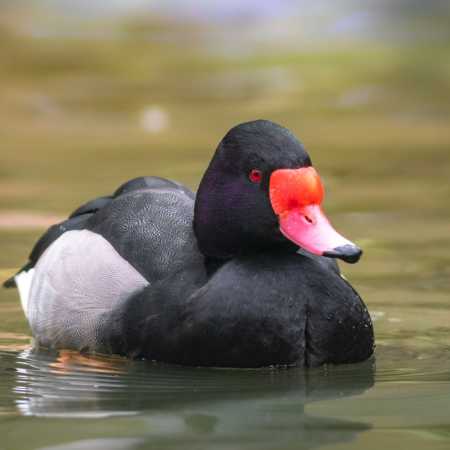When it comes to ducks, the most common feature that comes to mind is the classic yellow beaks. But did you know that some ducks have red beaks? These ducks are truly a sight to behold, a reminder of nature’s beauty and the diversity of our feathered friends.
In this blog post, we will dive deeper into the world of wild ducks with a red beak and what makes these beautiful birds special.
Muscovy Ducks
Muscovy Ducks

The Muscovy duck is a large duck native to Latin America, known for its unique iridescent black, white and red plumage.
- Males of the species are larger than females.
- These ducks inhabit many wetland environments such as lakes, urban parks and agricultural lands.
- They have an impressive range of vocalizations from soft cooing to loud honking while their strong wings allow them fly at great speeds and altitudes.
The wild Muscovy Duck (Cairina moschata) is a large duck native to South and Central America and is often kept for its meat, eggs, and feathers. It has an elegant appearance, with iridescent black, white, and red plumage and striking red facial caruncles (protuberances on the face) that are unique to the male of the species.
Muscovy ducks are large birds, with the male Muscovy ducks reaching up to 27 inches in length and weighing up to 8 pounds. The female Muscovy is slightly smaller, with a size of up to 24 inches and a weight of up to 4 pounds.
Muscovy ducks are versatile birds that inhabit many wetland environments, including lakes, urban parks, ponds and agricultural lands.
Muscovy ducks primarily feed on plant material, such as seeds, fruits, and roots, but they also feed on small aquatic animals, such as insects and snails. They are known for their strong beaks, which they dig in the mud and water to find food.
One of the most remarkable aspects of the Muscovy ducks is their unique vocalizations. These birds have a wide range of calls, ranging from a soft cooing to a loud honking. The call of the male Muscovy duck is particularly notable, as they have a deep, resonant quality that sets them apart from other duck species.
Muscovy ducks are also known for their unique flight patterns, as they possess strong wings that allow them to fly at great speeds and altitudes.
Besides ornamental purposes, domesticated Muscovy ducks are a popular choice for many small-scale farmers and homesteaders. They are hardy, easy to care for and provide many benefits. Moreover, they are among the best ducks to raise for eggs, meat, and even fertilizer.
Muscovy ducks are known for their unique flavor and texture of meat, making them a great choice for people looking for an alternative to chicken. On many restaurant menus, they are known as “barbary duck.” This domestic breed of duck is also referred to as mute duck.
Muscovy ducks mate many times in a year and female ducks are excellent layers, producing up to 200 eggs annually, allowing owners to enjoy a steady supply of fresh eggs.
Muscovy ducks can also help reduce pesky insect populations around their habitat, as they feed on insects, snails, and other pests.
Muscovy ducks are valued for their natural fertilizer. Their droppings are high in nitrogen, phosphorus, and potassium, making them a great natural fertilizer for gardens, lawns, and other crops.
Interestingly, the Muscovy duck is the only breed of domestic duck not related to the mallard. In some parts of the world, wild Muscovy ducks are considered an invasive species.
Mandarin Duck
Mandarin Duck

The Mandarin duck is native to East Asia, known its iridescent plumage and dazzling display of color.
- They form large flocks near water bodies .
- They are capable swimmers who feed mainly on plants & insects plus occasional fish or amphibian – foraging both land & underwater when necessary.
- These ducks form large flocks where males pair off stably from females.
The Mandarin Duck (Aix galericulata) is a species of duck native to East Asia celebrated for its striking and vivid appearance. It is often referred to as the “King of Ducks” due to its iridescent plumage and dazzling display of color. This species is well known for its unique beauty and is a highly sought-after addition to any ornithologist’s collection of observed birds.
The male Mandarin Duck has a striking appearance that sets it apart from other ducks. Its head and neck are a brilliant shade of vermilion, contrasting sharply with its white patches and broad wings.
The male’s breast is metallic green, and its back is a deep purple, which shimmers in the sunlight. This vivid coloration extends down to its legs and feet, an eye-catching shade of orange-red. Non-breeding males have brown feathers.
The female Mandarin Duck is a much more subdued color, with a brownish-grey plumage that blends well with its natural habitat. Despite this, she still possesses a subtle elegance and grace that is unique to the species. Her wings, which are brown with white specks, are particularly striking when seen in flight.
Mandarin ducks are gregarious birds and often form large flocks. Males and females form stable pairs. They are typically found near water bodies, such as rivers, lakes, and freshwater marshes, and are capable swimmers.
Mandarin ducks are omnivores that feed mainly on plants and insects, with an occasional fish or amphibian. They will eat seeds, berries, leaves, fruits, buds, flowers, and roots, as well as aquatic invertebrates like snails, dragonfly larvae, and aquatic insects. Mandarin ducks are often seen foraging for food on land, but they will also dive underwater when necessary.
Red-Crested Pochard
Red-Crested Pochard

The red-crested pochard is a dabbling duck native to southern Europe and Asia.
- They prefer shallow freshwater wetlands.
- The species is relatively non migratory.
- Its diet consists mostly of aquatic invertebrates.
The Red-crested Pochard (Netta rufina) is a vibrant and visually stunning dabbling duck native to southern Europe and Asia. It is known for the bright red crest on its head, where it got its common name. This crest is particularly noticeable in males and is key to identifying the species.
The male red-crested pochard also boasts a rich, chestnut-brown plumage on its back and wings, while its chest and belly are a creamy white color.
The female is somewhat drabber, with a mottled brownish-gray to light-gray plumage, but she is still a distinctive and striking bird in her own right.
Red-crested pochards are diving ducks that prefer habitats that are associated with shallow, freshwater wetlands. They are commonly found in marshes, ponds, lakes, and slow-moving rivers.
These large ducks also enjoy areas with plenty of vegetation, such as reedbeds, which provide them with a food source and protection from predators. During the non-breeding season, they tend to move to more saline habitats, such as coastal lagoons, estuaries, and brackish marshes.
The red-crested pochard is a relatively non-migratory species, though some populations may undertake short-distance movements in response to changing water levels or food availability.
It is omnivorous species that feeds on a wide variety of plant and animal matter. It mostly feeds on aquatic invertebrates such as aquatic insects, plankton, crustaceans, and small fish. While foraging on land, it eats seeds and grains, berries, and other fruit.
Rosy-Billed Pochard
Rosy-Billed Pochard

The rosy-billed pochard (Netta peposaca) is a diving duck native to South America.
- It has iridescent green feathers on its neck and a glossy green head.
- The bird forms large flocks often seen in the company of other ducks.
- It feeds on various aquatic plants & animals including invertebrates & small fish.
The rosy-billed pochard (Netta peposaca) is a diving duck native to South America and can be found in countries such as Argentina, Uruguay, Paraguay, and Brazil.
It is a distinctive species easily recognizable by its unique physical characteristics. It has iridescent green feathers on its neck and a glossy green head, which contrasts with its dark brown chest and belly. Its bill is large and prominent, and it is rosy-pink the species’ most distinctive feature.
The rosy-billed pochard is a sociable bird that forms large flocks and is often found in the company of other waterfowl species in coastal regions. It is an excellent swimmer and diver, and it feeds on various aquatic plants and animals, including aquatic invertebrates, crustaceans, and small fish. When not diving for food, the rosy-billed pochard can often be seen resting on the water’s surface or the banks of rivers and lakes.
Wood Duck
Wood Duck

The wood duck is a small-sized perching duck native to North America.
- This species can be found in various habitats such as wooded swamps and shallow ponds.
- It builds its nest inside tree cavities created by woodpeckers.
- It feeds on seeds, acorns or other aquatic vegetation.
The wood duck (Aix sponsa) is a perching duck with strong claws indigenous to North America. It is a highly prized species, not only for its beauty but also for its unique feature that set it apart from its mallard cousins.
The wood duck is a small-sized duck, with the adult male averaging around 19 inches in length and weighing approximately 1.5 pounds. The female is slightly smaller and lighter, averaging about 17 inches in length and 1 pound in weight.
The male wood duck has an iridescent plumage that ranges from deep chestnut to glossy green and purplish blue. The head of the male is adorned with a crest of feathers that resemble a crown, and his bill is colored in a contrasting white and black pattern.
On the other hand, the female is drab in comparison, with her plumage predominantly brown with white and black markings.
The wood duck is a highly versatile species found in various habitats, ranging from wooded swamps and shallow ponds to large rivers, coastal waters and streams. It is a strong flier known to cover great distances in its search for food, primarily consisting of seeds, acorns, and other aquatic vegetation.
One of the most distinctive features of the wood duck is its nesting habits. Unlike most ducks, the wood duck is a cavity nester, meaning it builds its nest in tree cavities, such as those created by woodpeckers. This behavior is unusual for ducks, who usually build their nests on the ground.
The female wood duck will lay between 7 and 15 eggs, which she incubates for approximately 28 days.
Torrent Ducks
Torrent Ducks

The torrent duck is native to the Andes mountain range in South America.
- Highly adapted for its habitat, it thrives in fast-moving streams and rivers.
- Its diet consists mainly of fish, crustaceans, mollusks which it captures using its sharp beak.
- It is an excellent swimmer.
The torrent duck (Merganetta armata) is a waterfowl native to the Andes mountain range of South America.
Males boast iridescent green heads with a distinctive crest of feathers on top of their heads, while their bodies are rich, chestnut brown with white speckling.
Female torrent ducks are less striking in appearance, with brownish-grey plumage and a more modest crest. However, both male and female Torrent Ducks have a distinctive white ring around their neck, which sets them apart from other species.
Torrent ducks are medium-sized birds with a body length of approximately 50 centimeters and a wingspan of 70 centimeters. They are relatively lightweight birds, with a weight of about 1 kilogram.
The torrent duck is a highly adapted species for its habitat, thriving in the fast-moving streams and rivers common in the Andes mountain range. These birds are excellent swimmers and divers, able to hunt for food and escape from predators easily.
They feed mainly on fish, crustaceans, and mollusks, which they capture with their sharp beaks.
Red-Billed Duck
Red-Billed Duck

The red-billed duck is a stocky duck native to Africa.
- It is easily recognizable by its distinct red bill.
- Its feeds mainly on aquatic plants, small crustaceans, and insect larvae.
- They communicate using vocalizations such as calls or other sounds.
The red-billed duck (Anas erythrorhyncha) is a species of duck that is native to sub-Saharan Africa. With its distinct red bill, this species stands out among its avian counterparts and is easily recognizable in its natural habitats.
The red-billed duck is a medium-sized species, measuring approximately 45-50 cm in length and weighing 450-600 g. It has a stocky build and a plump, rounded body that is well-adapted to its aquatic lifestyle.
The red-billed duck is a dabbling duck, meaning that it feeds by tipping forward in the water and scooping up food items with its bill. The bill is slightly curved and has a sharp, serrated edge, perfect for grasping food items from the water’s surface.
The plumage of the red-billed duck is mostly brown and gray, with lighter underparts and a darker, more mottled pattern on the back and wings. The male and female are similar in appearance, with the male slightly larger than the female.
The red-billed duck is a highly social species, typically living in large flocks and forming strong bonds with other group members.
The species is highly vocal, using a variety of calls and vocalizations to communicate with other ducks. The red-billed duck is an excellent swimmer, using its webbed feet to paddle through the water in search of food. It feeds on various items, including aquatic plants, small crustaceans, and insect larvae.
The red-billed duck is found throughout sub-Saharan Africa, inhabiting freshwater and brackish habitats, including lakes, rivers, and marshes. It is a migratory species that move to different areas in response to changing weather and food availability.
Key Takeaways on Ducks with Red Bills
- A Muscovy duck is a black duck with red beak.
- Red beaks on domestic ducks are pretty rare, but are more common in wild duck breeds.
- Muscovy ducks have a striking appearance of black and white feathers.

